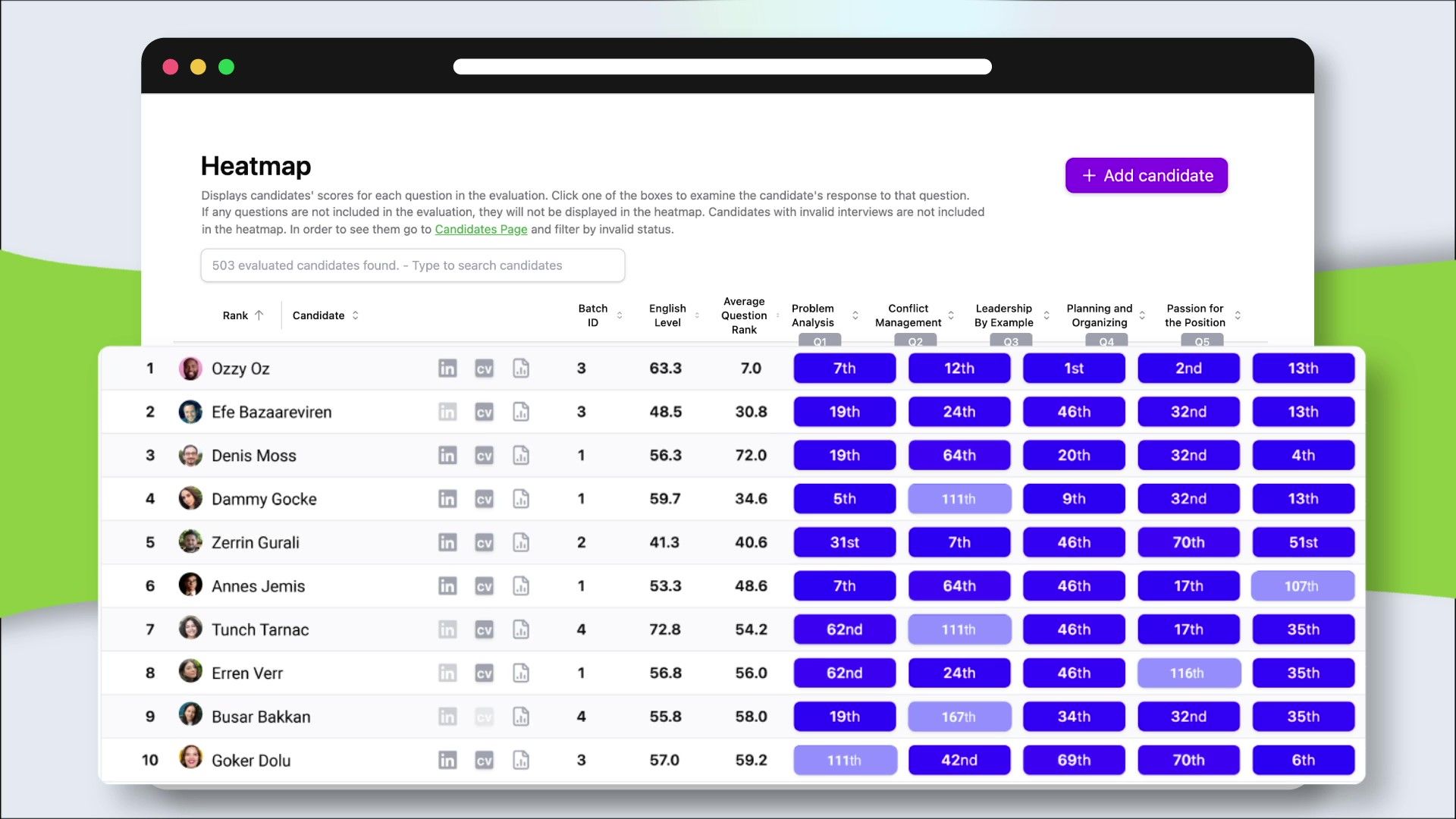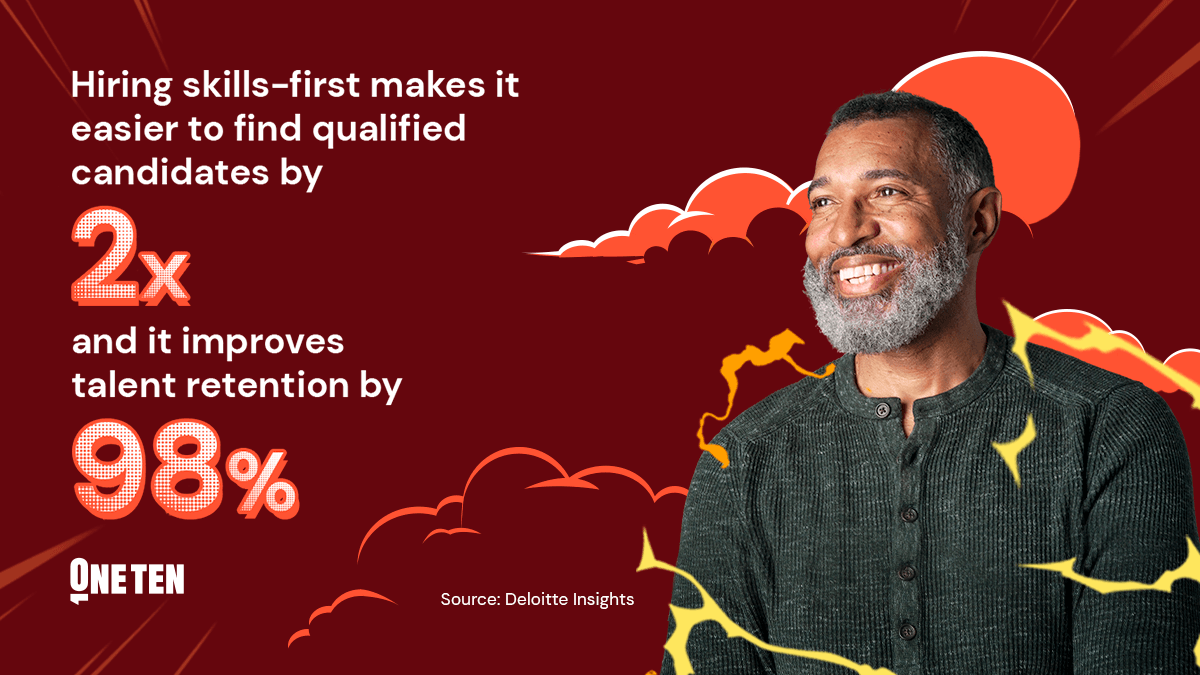Would you ignore a talent pool that stays with your company longer and delivers excellent results just because they lack a degree? Employees without a formal four-year degree tend to stay 34% longer in a company than those with a degree.
This means that if you’re still filtering out non-degree holders, you might be overlooking loyal, high-performing talents. And that’s just one instance of how fast the talent acquisition methods are changing.
If you also consider the rise of AI-powered job applications, remote-first teams, and skills-based hiring, it’s evident that traditional hiring models are becoming obsolete.
In short, talent acquisition has shifted from just hiring someone to fill an open role to strategically attracting and selecting the right people to drive business success.
This is why innovative HR leaders are ditching conventional hiring practices for future-focused strategies that prioritize agility, fairness, and long-term value.
That said, let’s discuss the top six game-changing talent acquisition strategies that will define success in 2025 and beyond.
Strategy #1: Applying Agentic Principles to Automated Screening
Modern talent acquisition leans on smart automation, especially AI-driven screening. (If you want a detailed post on how agentic AI transforms the recruitment process, read the full post here.)
Now, as a talent acquisition strategy, let’s discuss how agentic AI helps.
Freeing HR to Focus on Strategic Work
We'll use an example to clearly illustrate how embracing agentic AI principles like VireUp frees up your time to focus on strategic work.
In this scenario, you’re hiring a software engineer. You’ve posted on job boards and have shortlisted candidates via an ATS system. Now let’s see how you’d continue without VireUp as compared to the streamlined process with VireUp.
Without VireUp
- You schedule and conduct screening calls to ask the same basic questions, that is, if you’re performing structured interviews. (“Can you describe your last project?”, “What’s your experience with full stack development?” etc.)

An interviewer is having a screening call with an applicant
- You combine gut instincts, resume data, and scattered notes from your screening calls to decide who to move forward with.
This is repetitive, can lead to burnout of your team when you have many applicants, and may introduce human bias in the scoring of candidates.
With VireUp
Firstly, VireUp doesn’t disrupt your workflow. You can integrate it with existing HR tools and ATS systems.
-
Next, set up your interview questions. You can choose from the system's questions or input your own. Then, load up your candidates from the ATS and send them the interview link (in batches or all at once).
-
Candidates record their interview at their convenience within the specified deadline.
-
VireUp uses its human-led AI to evaluate candidates’ responses against the criteria you choose: technical depth, communication, cultural fit, and more.

VireUp’s heatmap can display thousands of candidates’ scores based on their responses
- You get a dashboard with the performance analytics and sentence-by-sentence evidence of how candidates performed against your requirements.
You see how the workflow with VireUp requires little to no human intervention? It does all the repetitive and time-consuming parts of your job as HR, leaving you with ample time to focus on strategy, final interviews, offer management, and onboarding.
Platforms that apply agentic principles, such as VireUp, help recruiters handle high-volume hiring without drowning in admin. However, when choosing an AI for your workflow, ensure it's built with transparency, compliance, and bias mitigation in mind.
You want a solution that clearly explains how decisions are made, aligns with ethical hiring standards, and complies with privacy laws like GDPR and EEOC. This will increase candidate satisfaction, improve trust, and ensure a fair analysis of interviews.
Staying Ahead of Cheating
Even as AI is becoming increasingly useful for HR leaders, job seekers also use it for AI-generated resumes, cover letters, and even fake AI profiles. So, in addition to the criteria stated above for choosing an AI solution for your hiring process, also look for those that can detect red flags.
VireUp, for example, gives you clear evidence for suspicious answers based on the content. So, you’re the ultimate judge.
Strategy #2: Tap the AI-Driven Talent Reshuffle
Big Tech is trimming head-count so it can pour billions into AI projects. Since January 2025, more than 50000 tech workers have been let go across Microsoft, Google, Amazon and Meta, with fresh cuts landing every month (TechCrunch lay-off tracker). Microsoft alone shed 7000 roles in May 2025 while earmarking a record $80 billion for AI data-centres (Reuters).
Why it matters to Talent Acquisition teams
-
Supply spike. Mid-to-senior engineers, product managers, and data scientists are flooding the market all at once, an opportunity that may last only a few quarters.
-
Remote-ready talent. Many ex-FAANG staff are already set up for hybrid or fully remote work, cutting relocation costs.
-
Culture boost. Alumni from high-rigour environments can lift engineering standards if you vet for skills, not brand names.
More strategies:
-
Map surplus skills to your gaps. Track new cuts on public boards such as Layoffs.fyi, or the TechCrunch list, and note which roles are over-represented. Build “fast-fill” job ads that mirror those competencies.
-
Fast-track screening. Combine a skills-first take-home or a structured video interview through VireUp with a 24-hour feedback promise. Speed is your edge while competitors run four-round loops that take weeks to complete.
-
Signal stability. Candidates affected by AI-based layoffs rank job security above perks. Share funding runway or traction data, such as profitability or customer metrics, early in the funnel.
Expected upside:
Early movers after the January cut cycle hired senior engineers 22% faster than their Q3 2024 average, according to the latest InformationWeek lay-off tracker. Capture even a fraction of this talent wave, and you’ll strengthen your bench while rivals are still rewriting their budgets.
Strategy #3: Building a Resilient Talent Pipeline
A talent pipeline is a proactive strategy in talent acquisition that involves building and nurturing a pool of potential candidates for future openings in your company. The reactive strategy is the conventional practice where you only start looking for candidates when there’s an opening. But this leaves your team scrambling when there’s a resignation. If you have a pool to choose from, it boosts agility.
Tapping Into Internal Mobility & Community Hiring
The first step to building a resilient talent pipeline is to assess the existing skills gap. Then, start with internal mobility. Your next hire might already be on your payroll; they just need the right opportunity and training.
So, with your knowledge of the company's existing skills gap, you can offer upskilling and mentorship programs to fill the gap. Upskilling employees reduces the cost of hiring new staff.
However, if internal employees are not an option, you should have a pool of external candidates sourced from career fairs, industry events, job boards, professional networks, and online platforms like LinkedIn. Maintain communication with them through webinars, newsletters, workshops, or networking events.
Moreover, with VireUp, you can store and revisit candidate interview data to consider them for future roles. Imagine a structured interview database rather than an obsolete CV database
Having a pool of qualified and engaged candidates handy is the best way to future-proof your workforce needs in today’s market.
Strategy #4: Refining Employer Branding & Candidate Experience
Did you know potential employees check your company reviews and overall brand image before applying for a job? Well, it’s true.
Other than former employees who rate your company on job boards, candidates who have gone through your hiring process can also share their experiences with their network. This can affect your employer branding, for good or bad.
Five years ago, a three-sentence job ad and an inefficient ATS were enough. Today, a single TikTok teardown of your interview script can sink your acceptance rate before dinner. Negative reviews float to the top of search, and candidates swap screenshots in real time. Keep running a pre-pandemic hiring journey, and you bleed credibility; fix the leaks now or watch your best prospects cross you off their list.
This necessitates creating a memorable candidate experience that shows your brand's values, culture, and respect for employees.
Differentiating Yourself in a Competitive Market
As mentioned earlier, people today value their work-life balance and employment environment. So they’re not just looking at salaries, but employer branding as well. This is especially true for top talents. They’re aware of their options and would not stick to companies that don’t align with their values. Their journey starts as early as your job posting and interview process.
To stand out in the competitive market, create a memorable candidate journey that attracts in-demand talent. Start from the very first touchpoint. This means clear job descriptions, fast and respectful communication, and personalized interviews.
If you are worried that the interview automation requires bog standard questions and criteria, you are very wrong. You can personalize interviews using AI for the screening process, and VireUp makes it possible.
The platform also offers video-based question delivery, where you can record your interview questions or use an AI avatar to deliver the questions to humanize the process and make candidates feel at ease answering questions. The video format tends to increase completion rates and candidate comfort.
With VireUp, you can deliver your interview questions via an AI avatar
Also, don’t ghost candidates. Build feedback loops into your process that give constructive feedback on why you can’t continue with unqualified candidates. It strengthens your employer brand and encourages top talent to try again in the future after filling gaps.
Strategy #5: Shifting to Skills-First Hiring
Have you ever skipped a CV because the title looked off, only to learn later that the candidate could do the job blindfolded? That mismatch is exactly why skills-first hiring is on everyone’s agenda now.
LinkedIn’s March 2025 Economic Graph study found that screening for provable skills rather than titles opens a talent pool six times larger and trims 18 days from the average time-to-hire. Larger pool, faster hires, fewer costly misfires: A trade-off any team can get behind. It also widens access for career-switchers and self-taught talent, bringing fresh perspectives you would never spot through keyword filters alone.
Let’s see a practical example of skills-first hiring for a content writer.
Traditional hiring might look like this:
-
Requires a Bachelor’s degree in English, Communication, or Journalism
-
Minimum of 3-5 years of experience in a similar role
Plus, the recruiter prioritizes job titles when going through applicants’ resumes.
Skills-first hiring, on the other hand, shifts the priority from all of the above and focuses on what the candidate can do, not where they’ve worked or the job titles they’ve held. The job post will highlight needed skills like:
-
Writing engaging SEO-optimized content
-
Adapting tone for different audiences
-
Using tools like WordPress and Grammarly
Then, applicants could be assessed with tasks like:
-
Submitting a writing sample on a relevant topic
-
Rewriting a bland paragraph for clarity and punch
-
Completing a short editing test or blog brief assessment

With this approach, someone without a degree or years of experience could still get hired if they can demonstrate strong writing, research, and editing skills. This opens up your talent pool to more applicants. But doesn’t that mean more work for HR professionals? Let’s see.
Moving Beyond Job Titles
Adopting the skills-first hiring model levels the playing field for all applicants and opens your talent pool to capable individuals who may otherwise be filtered out.
Plus, it ensures you get the best candidates because you’re looking beyond job titles and education to actually see if this person can do what the company needs. This helps your company become more agile by streamlining the recruitment process and reducing time-to-hire.
And yes, sorting through more applicants sounds like extra work, but that’s where AI-driven assessments or structured interview processes come in. In structured interviews, candidates get the same set of questions and are evaluated using the same scoring system or criteria.
So, from the start, you know what to ask and what you need from responses, making it easier to sort through applications.
Now, imagine using an AI tool that facilitates structured interviews and also analyzes responses to surface top candidates. This is a game-changer for skills-first hiring; thankfully, such tools exist. Tools like VireUp make skills-first hiring efficient even in high applicant volumes.
Strategy #6: Normalising Location-Flex Work
Hybrid work is no longer just a pandemic workaround; it is employees’ first choice. Gallup’s Hybrid Work Indicator shows six in 10 remote-capable employees prefer hybrid and fewer than one in ten want to be on-site full-time.

A remote team having a meeting online
Location-flex models benefit both employers (larger talent pools, smaller real-estate costs) and employees (better well-being, lower commute fatigue).
Expanding the Global Talent Pool
One of the limitations of on-site work models is that you’re limited to local talent. If you’re willing to get someone outside your geographical location, you may need to sponsor their visa. But remote work models remove geographical barriers.
As a result, you can hire the best person for the job, regardless of location. This opens the door to more diverse, specialized, and cost-effective candidates.
Hybrid work models have the same location constraints as on-site work, but they improve employees' flexibility and work-life balance. Consequently, they boost talent attraction and retention because today’s workforce prioritizes work-life balance.
The downside of working with a distributed team is that accountability, work culture, and collaboration might suffer if you don’t proactively manage them.
-
Set clear communication guidelines for collaboration and communication challenges, use inclusive communication tools like Slack, and schedule regular team-building activities to keep everyone connected.
-
Set clear, timely, and measurable goals to address accountability issues. Make deadlines and consequences clear from the start.
-
Hand over a digital culture handbook during onboarding that explains response-time norms, meeting etiquette, and decision-making frameworks. The Buffer State of Remote Work shows that 23% of remote workers cite loneliness as a top struggle, yet simple, structured check-ins lift connection scores markedly.
Lastly
Hiring in 2025 is speed chess. Big-tech cuts have pushed thousands of sharp engineers and product thinkers onto the board, and they will not stay there long. If you still filter candidates by pedigree while competitors test real skills, you are already a step behind.
Swap CVs for skills proof. Open your search beyond commuting distance, because hybrid is the new standard, and talent knows it. Let transparent AI workflows sift the routine stuff so your team can spend time on more important tasks. Keep showing up where future hires gather and tag strong interview clips for next week’s surprise vacancy.
Stay with the old playbook and you will keep hiring, just slowly, at a huge cost, and from the pile others declined. Make these shifts and you fill seats faster, fairer, and with people your rivals wish they had called first.
FAQs
- What are the most current and innovative talent-acquisition strategies?
Organisations are focusing on six areas: Using the recent wave of Big-Tech layoffs to access experienced talent, adopting skills-first hiring to widen candidate pools and shorten time-to-hire, introducing human-oversight AI screening to handle large volumes consistently, offering location-flex work as the new standard, strengthening employer branding and candidate experience for transparency and speed, and maintaining a resilient talent pipeline through internal mobility and community engagement.
- What is skills-first hiring?
Skills-first hiring ranks candidates on demonstrable abilities rather than degree credentials or previous job titles. Job ads list required competencies, and applicants prove proficiency through work samples or structured interviews. The approach typically enlarges the qualified talent pool and reduces hiring timelines.
- How is AI used in recruiting today?
AI supports recruiters by parsing CVs, scheduling interviews, evaluating recorded responses against predefined criteria, and presenting evidence-based shortlists. Human oversight remains essential to verify transparency, fairness, and compliance with privacy and anti-bias regulations.
- What defines a resilient talent pipeline?
A resilient pipeline is a curated pool of internal and external candidates who remain engaged through periodic touchpoints such as upskilling sessions, newsletters, and invitation-only events. Storing structured interview data allows recruiters to revisit promising candidates quickly when similar roles open.
- Which KPIs are most useful for monitoring recruitment performance?
Commonly tracked indicators include time-to-hire, cost-per-hire, qualified-candidate ratio, 90-day retention, and candidate-experience scores. Reviewing these metrics each quarter helps identify process bottlenecks and optimise budget allocation.




